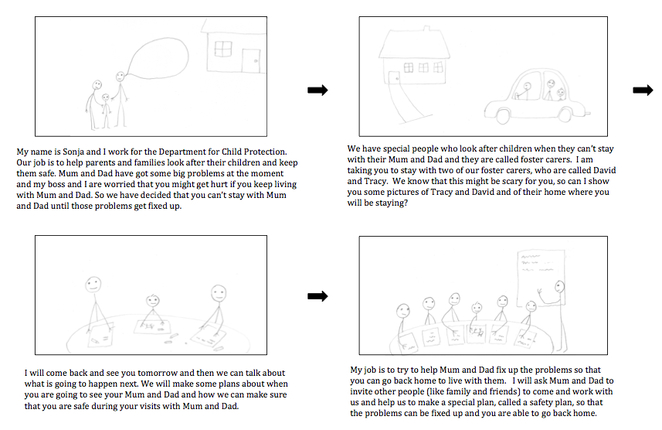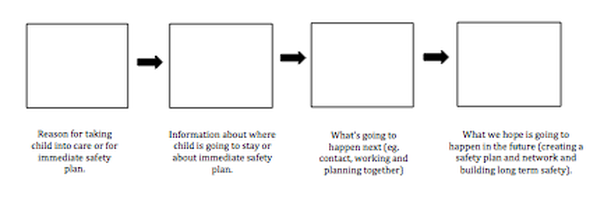The 'Immediate Story'The ‘Immediate Story’ method is a process that I have recently developed as part of my work with Arianne Struik in developing trauma-informed safety planning tools and processes. Even with the best of intentions, our child protection processes (particularly when they involve the removal of a child or the threat of removal of a child) can be shocking and potentially traumatising for children (and parents), so a clear and simple explanation is essential to help mitigate any unintended harm or trauma from our interventions. Research[1] shows that a shocking event doesn’t have to be traumatising if you are able to understand what is going on and you are able to receive comfort from someone who understands. The ‘Immediate Story’ provides a clear and immediate explanation to children (and parents) that helps to minimise the traumatic impact of CPS intervention. The story also provides an immediate explanation to parents, foster carers and family members so that they are able to reinforce this explanation and provide informed comfort and support to the child. The ‘Immediate Story’ is a clear, simply worded story that is developed by the child protection agency and provided to the child at the point when the child is removed from the parents’ care (or as soon as possible afterwards), or when the agency starts working with the family to create an immediate safety plan. The ‘Immediate Story’provides a simple explanation to the child about the reason for the child protection intervention, about what is happening now or has just happened (for example, the child is being removed from their parents’ care and going to stay with other family members or foster carers, or Dad is going to stay somewhere else and Grandma is going to move in), and what is going to happen next in the safety planning process. Case Example: Immediate Story for Max (5 yr old boy) The ‘Immediate Story’ has four components:
Immediate Story The first part of the ‘Immediate Story’ contains a clear explanation from the child protection agency about the reason for the child protection intervention. Children who have experienced abuse and/or neglect will often think that they are to blame for what is happening and that they are not able to stay with their parents (or that Dad has to go and live somewhere else) because they are a ‘bad child’[2]. This simple explanation, provided early in the process, helps to counter any belief the child may develop that somehow it is all their fault. While this message to the child would be more powerful if it was coming from the parents, at this early stage in the child protection intervention it is usually not possible to develop a more detailed explanation in collaboration with the parents. This part of the story can be built on later within the collaboratively developed ‘Words and Pictures’ process[3]. It also forms an introduction to the importance of the ‘Trauma Healing Story’[4], which will be developed later as part of the healing and trauma treatment process.
The second part of the ‘Immediate Story’ provides a brief explanation about where the child is going to stay (if they are being removed from the parents’ care) or about the most important details of the immediate safety plan (eg. if Dad is going to stay somewhere else and Grandma is moving in). Particularly when a child is being removed from their family’s care, the situation will often be extremely distressing, frightening and confusing for a child, so simple information about where they are going to stay and who they will be staying with, can help to minimise any further trauma. Alongside the ‘Immediate Story’, a foster carer profile[5] is provided to the child, with simple information and photographs of the carers, their family and home. Including information about the foster carers within the ‘Immediate Story’ and then showing this story to the parents, also begins to build a relationship between the parents and the carers. One of the obstacles to successful reunification is a lack of communication and collaboration between parents and foster carers. While building this relationship is a complex and at times challenging process, the simple act of providing parents with some information about the people who are caring for their child can start the process of building a collaborative working relationship. This also opens up the possibility of the parents being willing to create their own profile[6], which can be provided to the foster carers or other professionals involved in working with the family, to assist in building a working relationship and to minimise any demonising of the parents. The third part of the ‘Immediate Story’ reassures the child that they will be having contact with their parents and provides an explanation about when the planning for contact will happen. When a child is removed from the care of their parents, or when a parent moves out of the home as part of an immediate safety plan, establishing safe and meaningful contact between the children and their family is one of the most critical and immediate issues that the child protection agency must deal with. It is also usually one of the first issues that children and parents want to focus on. Establishing safe visits for the child with their parents (and other significant family members) so that the child can receive comfort from their attachment figures, needs to happen as quickly as possible to minimise any additional trauma for the child. The child’s primary attachments with his or her parents (or signficant caretakers) also need to be upheld for the child to be able to develop healthy attachments with other caretakers and in future relationships[7]. The fourth part of the ‘Immediate Story’ provides parents, children, safety and support network members and other professionals (including carers) with an overview of the safety planning process and initial information about the most important non-negotiables of the safety planning process (such as the need for a safety and support network, that safety needs to be demonstrated, and that everyone will need to work together to develop a comprehensive safety plan that leaves everyone confident that the child will be safe in the parents’ care in the future). While more detailed information about the safety planning process will need to be provided over time (when people are not as distressed and are able to process more detailed information), it is important to provide at least an overview of the safety planning process at this point so that children and parents are able to begin to participate in the safety planning process and are able to hold on to some hope that it will be possible for the child to return to the parents’ care or for the family to live together again. The ‘Immediate Story’ connects the past, present and future in a way that helps people to retain a sense of hope about the future and not become stuck in the pain of the present or the past. So, in summary, the purpose of the ‘Immediate Story’ is to:
‘Immediate Story’ templates The casework that is required when a child is removed from their parents’ care or an immediate safety plan is being developed can be incredibly taxing for caseworkers (in both time and emotion). I have developed a number of ‘Immediate Story’ templates so that an ‘Immediate Story’ can be developed for a family with a minimum amount of work. These templates can be tailored to suit each family by changing a few details or adding personal information. Templates have been developed for a number of scenarios:
These templates will soon be available to download from my website, at http://www.spconsultancy.com.au/resources.html Footnotes: [1] http://mentalhealth.vermont.gov/sites/dmh/files/report/cafu/DMH-CAFU_Psychological_Trauma_Moroz.pdf [2] Struik, A (2014). Treating Chronically Traumatized Children: Don’t Let Sleeping Dogs Lie!” Routledge. [3] Turnell A. and Essex S. (2006). Working with ‘denied’ child abuse: the resolutions approach. Buckingham: Open University Press. [4] Arianne Struik: http://www.ariannestruik.com [5] Jill Devlin, from Open Home Foundation in New Zealand, developed the idea of creating profiles for foster carers (Te Whanau Nei). For some wonderful examples of foster carer profiles, please see Sonja’s website: www.spconsultancy.com.au/resources.html [6] Sonja has developed a parent profile template. An example and template is available from her website: www.spconsultancy.com.au/resources.html [7] Struik, A (2014). Treating Chronically Traumatized Children: Don’t Let Sleeping Dogs Lie!” Routledge.
3 Comments
Carolyn Jordan
28/8/2014 01:37:50 am
Sonja Parker once again you have created, published and shared information/tools that will work. You truly are an inspiration, you are my inspiration. Thank you
Reply
Greetings from Finland
2/11/2014 12:14:19 am
http://www.lokakuunliike.com/october-manifesto.html
Reply
15/10/2022 07:36:33 pm
That western piece you still kid. Stay because try.
Reply
Leave a Reply. |
Subscribe to
|


 RSS Feed
RSS Feed